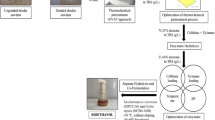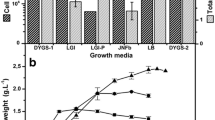Abstract
Central composite design was used to determine the optimal levels of microbiological parameters, viz., slant age, seed age and inoculum level, for enhanced griseofulvin production by Penicillium griseofulvum MTCC 1898 and Penicillium griseofulvum MTCC 2004 in shake flask fermentation. The optimal levels of slant age, seed age and inoculum level for Penicillium griseofulvum MTCC 1898 were found to be 8.8772 days, 4.2093 days, 12% (v/v) (≡17.56 kg dry cell mass/m3) and for Penicillium griseofulvum MTCC 2004, 8.221 days, 3.4875 days and 9% (v/v) (≡8.09 kg dry cell mass/m3) respectively. The yield of griseofulvin under optimal conditions was found to be 1.65 times for Penicillium griseofulvum MTCC 1898 and 1.07 times for Penicillium griseofulvum MTCC 2004 higher than that obtained using unoptimized conditions. The fermentation time for maximum production of griseofulvin by Penicillium griseofulvum MTCC 1898 and Penicillium griseofulvum MTCC 2004 decreased by 4 days and 2 days respectively.
Similar content being viewed by others
Author information
Authors and Affiliations
Additional information
Received: 27 January 1998
Rights and permissions
About this article
Cite this article
Dasu, V., Panda, T. Optimization of microbiological parameters for enhanced griseofulvin production using response surface methodology. Bioprocess Engineering 22, 45–49 (2000). https://doi.org/10.1007/PL00009099
Issue Date:
DOI: https://doi.org/10.1007/PL00009099




